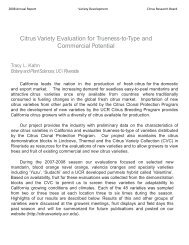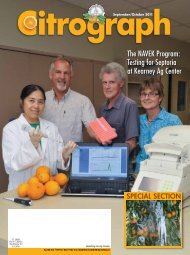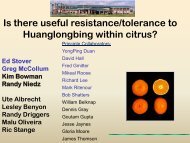2008 Michael L Roose (Rootstock Breeding & Evaluation) - Citrus ...
2008 Michael L Roose (Rootstock Breeding & Evaluation) - Citrus ...
2008 Michael L Roose (Rootstock Breeding & Evaluation) - Citrus ...
Create successful ePaper yourself
Turn your PDF publications into a flip-book with our unique Google optimized e-Paper software.
<strong>2008</strong> Annual Report Variety Development <strong>Citrus</strong> Research Board<strong>Citrus</strong> <strong>Rootstock</strong> <strong>Breeding</strong> and <strong>Evaluation</strong>Mikeal L. <strong>Roose</strong>Botany and Plant Sciences, UC/Riverside<strong>Citrus</strong> rootstocks are the foundation of any citrus grove, and choosing a rootstock is typically a decision that affectsperformance and profitability for the life of the grove. The objective of this project is to provide the California citrus industry with awider diversity of rootstocks and with information that allows the optimal rootstock to be chosen for a given site. The current range ofrootstocks does not include good options for specific conditions, such as calcareous soil types, long-term compatibility with mandarinsand lemons, strong resistance to all citrus nematode biotypes, and tolerance or resistance to new threats such as Diaprepes root weevil.Development of new rootstocks involves production of hundreds of potential new varieties by hybridization, screening thesefor essential or important traits including seed production, trueness-to-type, Phytophthora root rot tolerance, citrus nematoderesistance, tristeza virus tolerance, tolerance to calcareous soils, etc. Candidate rootstocks then enter field trials to evaluate theireffects on yield, tree size, fruit quality, compatibility with important scion varieties, and other traits. All of this requires many years ofeffort. Progress on the specific objectives of the 2007-<strong>2008</strong> proposal is summarized below.Porterville location of new rootstock trial for Tangomandarin planted in June <strong>2008</strong>.Figure 1.
<strong>2008</strong> Annual Report Variety Development <strong>Citrus</strong> Research Board<strong>Evaluation</strong> of 18 existing rootstock trials: Tree size and heath measurements and photographs were collectedfrom four trials in Ventura Co. Yield records were collected from trials at UCR and Lindcove as originallyplanned. Packout data were collected for Atwood navel and Lane Late navel trials at Lindcove. A fruit qualitystudy was completed for trees on the 29 rootstocks in the Lane Late navel trial at Lindcove.A 2005 trial to evaluate compatibility and performance of Fukomoto from 9 bud sources on Carrizo, C35, andVolk was evaluated in October 2007. Most trees were in good health, and there were no significant effects ofrootstock or bud source on tree health ratings. <strong>Rootstock</strong> suckers were highest for trees on Volk, and lowest forthose on Carrizo. However, the number of scion sprouts at the budunion, a symptom of compatibility problems,was significantly higher for trees on C35 and Carrizo (4.5-4.8) compared with those on Volk (2.6). This trial wasevaluated again in December <strong>2008</strong> and analysis of these results should be more informative about this possiblecompatibility issue.A 2006 tristeza tolerance trial at South Coast Research and Extension Center (Irvine) includes 784 trees,with 50 rootstocks each having 16 trees. Four trees of each rootstock were inoculated with each of four CTVisolates, and 95% test positive. Although it is not possible to maintain virus-free control trees at this location,trees testing negative for CTV were larger than those testing positive. By November <strong>2008</strong>, 4 of the 16 trees on sourhad died, and none had health ratings above 3.0 on a 0-5 scale. In contrast, for Carrizo, a CTV- tolerantrootstock, no trees had died and all had health ratings above 3.5. It is too early to determine if rootstock tolerancevaries with CTV isolate, but ASRT appears stunted by CTV as reported previously by Florida scientists (Figure 1).In the 2001 Elderwood Heights trial for oranges on calcareous soil, the largest trees were on C54, Schaubrough lemon, and African shaddock x Rubidoux trifoliate, with small trees on Rich and 4008 trifoliate, a Sour+ Carrizo somatic hybrid from the University of Florida, and some other experimental hybrids. Tree size was notwell correlated with iron chlorosis rating, as some trees with substantial chlorosis were relatively large. Thelowest chlorosis ratings were for trees on C22, a Sour x Cleo hybrid, a Rangpur x Shekwasha hybrid, and aNova+HB pummelo somatic hybrid from the University of Florida, Detailed tables that summarize data onseveral trials are available on the project web site (http://www. plantbiology.ucr.edu/people/?<strong>Roose</strong>).New trials for mandarins: Seedlings of 23 rootstocks were initially grown at Lindcove and latertransferred to TreeSource Nursery who grew the trees at no cost to the project. Seedlings were budded withTango mandarin, and one trial of 11 replications was planted in June <strong>2008</strong> with cooperator Harrison Smith on aPorterville Adobe soil (Figure 2). Additional trees will be planted in spring 2009 on different soil types nearBakersfield (Johnston Farms) and Orosi (Arlen Miller).Iron chlorosis tolerance screening: A 2007 experiment testing 36 varieties was continued until October <strong>2008</strong>and identified two new hybrids with tolerance approaching that of sour orange. For a new <strong>2008</strong> experiment, seedswere collected from 14 standard rootstocks and 199 new hybrids and grown in a greenhouse at UCR. Seedlingpopulations of 51 varieties that had adequate uniformity were selected for screening, transplanted into soil mixsupplemented with 0, 5% and 15% calcium carbonate, and monitored for growth and chlorosis after 3 months.Nearly all rootstocks performed similarly at 5 and 15% calcium carbonate, and one very promising new hybridwas identified. Several others had good tolerance.
<strong>2008</strong> Annual Report Variety Development <strong>Citrus</strong> Research BoardPhytophthora root rot resistance: Seedlings of 61 selected hybrids and standard rootstocks were tested forresistance to Phytophthora parasitica (supplied by Greg Douhan’s lab) in <strong>2008</strong>. The most tolerant rootstocks(those growing the most roots after inoculation) included ASRT, Swingle, C35, Pomeroy trifoliate and manyexperimental hybrids (mostly pummelo x Swingle and pummelo x Flying Dragon). Sweet orange, Carrizo, and(surprisingly) sour orange and Flying Dragon were among the most susceptible rootstocks in this test. A secondtrial evaluating a mostly different set of 35 rootstocks for P. citrophthora during winter <strong>2008</strong> identified a fewtolerant rootstocks, including Pomeroy trifoliate, C35, and some experimental hybrids, but most standardrootstocks (including sour orange) and hybrids were quite susceptible.New releases: We summarized data on three new rootstock hybrids of Sunki mandarin x Swingle trifoliateparentage, tested as C22, C54, and C57, and tentatively named Bitters, Carpenter, and Furr respectively. Release ofthese rootstocks should occur in June 2009 when CCPP will have screenhouse budwood sources that havecompleted a full VI test.Note: The research results included in this publication are summary reportsfor the benefit of the <strong>Citrus</strong> Research Board and the growers it serves.They are not to be taken as recommendations from either the individualreporting or the agency doing the research. Some of the materials andmethods mentioned are neither cleared nor registered for commercialuse. The summaries were written by the project leaders indentified.Both Technical names and registered trademarks of materials are usedat the discretion of the authors and do not constitute any endorsementor approval of the materials discussed. Questions on possibleapplications should be directed to the local University of CaliforniaExtension Specialist, a licensed PCA, or the appropriate regulatory agency.
















